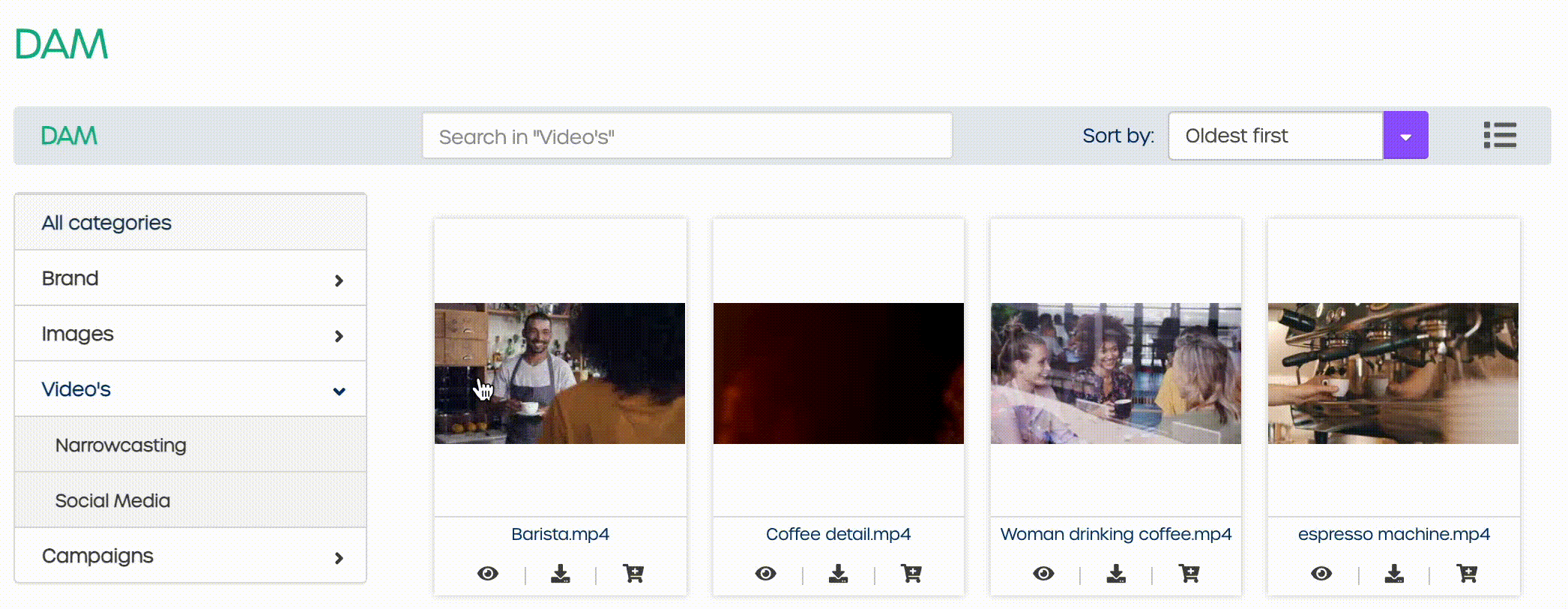
What Is Digital Asset Management (DAM) And How It Impacts Your Business
Last updated: October 7, 2025
Effectively branding your business requires a plethora of high-quality digital assets. Every piece of content you leverage to promote your products or services is valuable and drenched in labor, love, and creative energy. So, what happens when those amazing assets get lost in an endless dungeon of folders? As your proverbial ocean of digital assets grows, your business needs to effectively manage these assets in a way that sparks productivity, creativity, and efficiency.
Unfortunately, it's easy to lose track of digital assets. Employees spend countless hours diving through webs of files, emails, Dropbox folders, and Slack messages to uncover that precious asset. In the meantime, your business is losing productivity, revenue, and time. So, how do you rally your massive digital ecosystem under one roof, and how can you eliminate the desperate search-and-find missions?
Simple. You use a Digital Asset Management (DAM) platform.
What is Digital Asset Management?
Digital Asset Management is essential for managing diverse digital content efficiently. Modern DAM systems offer more than just storage and organization; they feature advanced search, AI-powered tagging, and integration with key marketing and creative tools, streamlining content management. These platforms are pivotal in maintaining brand consistency, optimizing digital workflows, and enhancing collaboration. With DAM, accessing and sharing digital assets like photos, videos, and documents becomes effortless and fast. It transforms content discovery, eliminating the need to sift through disorganized digital storage, and enables users to leverage their digital assets fully.

Benefits of Digital Asset Management
In today's digital-first world, where 82% of marketers prioritize content marketing, Digital Asset Management systems are indispensable. They serve as the backbone of marketing campaigns, fueling customer engagement and driving strategic initiatives. Each digital asset, from images to documents, holds significant value, which DAM systems expertly manage and amplify. Below are key benefits, reflecting the evolving landscape of digital asset management:
- Enhanced Security: With cyber threats escalating, DAM provides robust protection for digital assets. Advanced security features like cloud-based safeguards and customizable access rights defend against data breaches, ensuring your content remains secure.

- Increased Productivity: Research shows that employees can spend up to 30% of their day searching for information. DAM systems dramatically reduce this time, enabling quick access to necessary digital assets, thereby boosting productivity and profitability.
- Streamlined Efficiency: DAM facilitates seamless collaboration, both internally and with external partners. For instance, photographers can directly upload to the DAM, speeding up the marketing process.
- Robust Copyright Protection: Intellectual property theft is a growing concern. DAM systems safeguard against this with tools like automated watermarking and publishing rights management, protecting the integrity of your creative work.
- Value Creation and Repurposing: DAM platforms provide a comprehensive view of your digital assets, facilitating their efficient use and repurposing. This approach not only extends the lifespan of your content but also enhances its overall value.
- Ease of Use and Employee Satisfaction: Considering that employee dissatisfaction often stems from inefficient workflows, DAM systems offer a user-friendly solution. By simplifying the storage, organization, and utilization of digital assets, DAM systems contribute to a more satisfied and efficient workforce.
These benefits underscore the transformative impact of DAM systems in today's content-driven business environment, highlighting their role in security, efficiency, and value creation.
Who Should Use A Digital Asset Management System?
The necessity of a Digital Asset Management system transcends industries and business sizes: it's universal. In an era where digital content proliferates at an unprecedented rate, every company — be it in retail, food and beverage, finance, healthcare, or education — stands to benefit from a DAM system. The value embedded in each digital asset is immense, whether it's a product image, a marketing video, or brand materials.
Effective campaign execution, captivating video production, and consistent branding all hinge on having organized, easily retrievable, and well-maintained digital assets. Without DAM, businesses risk losing precious time and resources searching for assets that might be lost or outdated.
The justification for adopting a DAM system is straightforward. It's challenging to find a scenario where a DAM wouldn't significantly streamline operations and enhance productivity. In essence, DAM is not just a tool; it's a fundamental component of a smart, efficient, and forward-thinking digital strategy.
→ Discover 6 key reasons why your marketing department needs DAM
What Can A DAM Do For You?

Are you aiming to elevate your marketing campaigns with top-notch creative assets? Frustrated by the inefficiencies and lost productivity in tracking down critical information? Looking to empower your team with quick access to essential digital assets? A Digital Asset Management system is the solution you've been searching for. It’s more than just an improvement to your asset workflows; it’s a game-changer for your entire business approach.
DAM systems revolutionize how you manage marketing, sales, and overall business strategy. They serve as a comprehensive repository for all digital assets, providing an intuitive and easily navigable system for every user in your organization. This isn’t just about organizing files; it’s about transforming the core of your business operations, making them more efficient, cohesive, and strategically aligned. With DAM, you're not just managing assets; you're unlocking their full potential to drive business success.
How Select the Right DAM System
Choosing the right DAM system isn't always easy. On the surface, questions relating to cloud capabilities, speed, and UI are all important. But the truth is: that many DAM systems have user-friendly UIs and robust cloud architecture. After all, the availability of hyper-scalable cloud platforms like AWS, Azure, and Google is even the playing field. Chances are, your DAM system uses a well-known cloud provider, offers scalability, and has a modern UI. If not, you should obviously choose a different platform. But we won't discuss those more obvious requirements. Instead, let's focus on capabilities.
In general, you should be able to answer yes to the following questions:
- Does your system make it easy to find digital assets? Smart search is incredibly important for DAM systems. You should be able to quickly find digital assets based on metadata like size, date, format, etc. If your DAM doesn't make searching easy, it's not providing you with real value.

- Does the system have user controls? Cybersecurity is front-of-mind for businesses in today's threat landscape. Hackers attack every 39 seconds, and a single breach can cost you millions of dollars in damages. Here's the kicker: 30% of data breaches involve internal actors. Only the right people should be able to view content at the right time. Make sure your DAM has robust user controls and privileges.
- Can you preview your content? This is actually a major concern. File names and dates don't always paint a full picture. To find the right asset, you need to see what it looks like. Unfortunately, many DAM systems don't provide you with a preview feature. So, your employees have to painstakingly open each individual asset (in its correct program) to find the right content. Suddenly, employees are wasting time looking for information again. Previewing is a bigger deal than it seems, especially if you deal with a variety of content types (e.g., videos, audio, documents, etc.)

- Can you effectively share content? With remote work evolving into a de facto part of work culture, sharing via links and channels is a crucial component of the modern workflow. You need your DAM to support quick sharing for expedited workflows.
- Are you capable of protecting and controlling your precious digital assets? Cybercrime is constantly growing. Malware and breaches get all the attention, but asset theft is another huge issue. Your DAM should both protect your content and enable its protection across mediums. For example, Marvia allows you to add watermarks, expiration dates, and publication rights to each digital asset.
- Do you need to log-in to upload? Content comes from a variety of sources, and not all of those sources exist in your organization.
 For example, outsourced photographers and copywriters create amazing assets for your company. Should they really have to send those assets to an employee via email? It doesn't make sense. Emails get lost, and employees don't need to transform into upload robots. Choose a solution that allows uploading via secure links without a log-in. This way, you don't have to share credentials with third-party content creators, but you can also have them upload content as a natural part of their workflows.
For example, outsourced photographers and copywriters create amazing assets for your company. Should they really have to send those assets to an employee via email? It doesn't make sense. Emails get lost, and employees don't need to transform into upload robots. Choose a solution that allows uploading via secure links without a log-in. This way, you don't have to share credentials with third-party content creators, but you can also have them upload content as a natural part of their workflows.
When Is The Right Time to Invest in Digital Asset Management?
Today! Every business stands to gain from a DAM system. Even if you're a massive enterprise with a robust cloud architecture, DAM systems give you a competitive edge. In fact, large companies often have the messiest digital asset ecosystem. Between cloud buckets, data lakes, SaaS servers, emails, app channels, Dropbox folders, and personal computers, larger enterprises often have a smorgasbord of content scattered across their organization. Converging all of these assets into a single solution saves you time, money, and headaches.
For small businesses that have yet to embark on a branding journey, digital asset management systems may seem like a wasted investment. But they're not. DAM platforms scale with your business. The sooner you use them, the more value you gain. In fact, small businesses that onboard DAM systems early in their branding journey stand to gain a significant advantage over their competitors. Not only do DAM systems expedite your creative workflows, but they keep your early-stage assets preserved for later use — helping you create brand consistency.
Are You Looking to Manage Your Digital Assets?
Your brand's assets are critical drivers of growth. Don't let them fall to the wayside. We can help. Marvia's industry-leading DAM platform is used by over 80.000 users to secure and organize their precious assets.
Struggling to organize your digital assets? Marvia's DAM solution can solve this! Schedule a demo to see how we can optimize your workflow.
> Click here to request your free demo today!
Editor's note: This article was originally posted in April 2018 and has been updated to include additional information and tips.
